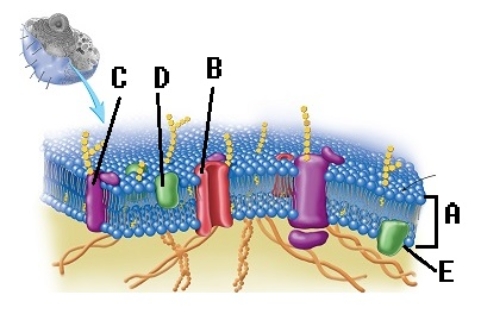A) 1,2,3,4,5
B) 2,1,3,5,4
C) 2,4,5,3,2
D) 2,3,5,4,1
E) 2,3,4,5,1
Correct Answer

verified
Correct Answer
verified
Multiple Choice
Which of the following are consistent with facilitated diffusion? (1) movement is against a concentration gradient (2) movement is with a concentration gradient (3) involves a carrier molecule (4) involves cotransport (5) involves counter transport (6) exhibits competition and saturation
A) 1,2,4,5,6
B) 2,3,5,6
C) 2,3,4,6
D) 1,3,4,5,6
E) 2,3,6
Correct Answer

verified
Correct Answer
verified
Multiple Choice
 -What structure does "B" represent on the diagram of the plasma membrane?
-What structure does "B" represent on the diagram of the plasma membrane?
A) internal membrane surface
B) membrane channel protein
C) phospholipid bilayer
D) peripheral protein
E) integral protein
Correct Answer

verified
Correct Answer
verified
Multiple Choice
Cells produce and respond to chemical and electrical signals as a means of
A) synthesizing.
B) communicating.
C) metabolizing.
D) using energy.
E) reproducing.
Correct Answer

verified
Correct Answer
verified
Multiple Choice
Microtubules
A) are a component of mitochondria.
B) are the smallest components of the cytoskeleton.
C) provide structure and support to the cytoplasm.
D) contain the protein myosin.
E) are solid,supporting rods of protein.
Correct Answer

verified
Correct Answer
verified
Multiple Choice
A cell with abundant peroxisomes would most likely be involved in
A) detoxification activities.
B) secretion.
C) protein synthesis.
D) storage of glycogen.
E) cellular communication.
Correct Answer

verified
Correct Answer
verified
Multiple Choice
Which of the following is NOT a characteristic function of a cell?
A) reproduction and inheritance
B) communication
C) movement
D) metabolism and energy use
E) synthesis
Correct Answer

verified
Correct Answer
verified
Multiple Choice
The organelle that protects cells from the damaging effects of medications and toxins is the
A) microtubule.
B) mitochondria.
C) ribosome.
D) secretory vesicle.
E) smooth endoplasmic reticulum.
Correct Answer

verified
Correct Answer
verified
Multiple Choice
 -What structure does "D" represent on the diagram of the plasma membrane?
-What structure does "D" represent on the diagram of the plasma membrane?
A) integral protein
B) phospholipid bilayer
C) internal membrane surface
D) membrane channel protein
E) peripheral protein
Correct Answer

verified
Correct Answer
verified
Multiple Choice
What type of cell would have an abundance of lysosomes?
A) liver cells that detoxify hydrogen peroxide
B) fibroblast (makes protein fibers)
C) white blood cell,a phagocyte
D) cardiac muscle cells (require large amounts of ATP)
E) mucus cell (secretes mucus)
Correct Answer

verified
Correct Answer
verified
Multiple Choice
Check all of the major theories of aging.
A) Damage to mitochondria.
B) Damage to the DNA from free radicals.
C) Damage to lysosomes.
D) Presence of a "cell death clock".
E) Presence of "death genes".
Correct Answer

verified
Correct Answer
verified
Multiple Choice
Mitochondria
A) contains DNA.
B) have inner and outer membranes.
C) have inner folds called cristae.
D) are the cell's power plants.
E) All of these choices are correct.
Correct Answer

verified
Correct Answer
verified
Multiple Choice
Which of the following would increase the rate of mediated transport?
A) change the shape of the binding site on the carrier molecule
B) increase the number of competitive molecules
C) remove the binding site on the carrier molecule
D) fill all binding sites on carrier molecules
E) increase the number of available carrier molecules
Correct Answer

verified
Correct Answer
verified
Multiple Choice
Which of the following is NOT posttranslational processing?
A) conversion of a pro-protein to a functional protein
B) conversion of a pro-enzyme to a functional enzyme
C) joining 2 or more amino acid chains
D) adding polysaccharide side chains to proteins
E) removal of introns from pre-mRNA
Correct Answer

verified
Correct Answer
verified
Multiple Choice
In which part of the cell cycle do chromosomes align along the equator?
A) prophase
B) metaphase
C) anaphase
D) interphase
E) telophase
Correct Answer

verified
Correct Answer
verified
Multiple Choice
Absence of a cytoskeleton might affect
A) cell shape.
B) the ability of the cell to generate energy.
C) membrane transport.
D) vesicle formation.
E) the number of channel proteins in the cell membrane.
Correct Answer

verified
Correct Answer
verified
Multiple Choice
Organelles
A) are unspecialized portions of a cell.
B) are extracellular structures.
C) vary in number and type depending on cell function.
D) are structural,but not functional parts of the cell.
E) generally lack membranes.
Correct Answer

verified
Correct Answer
verified
Multiple Choice
The anticodon sequence GUA pairs with which of the following codons?
A) CAU
B) CAT
C) CTU
D) CTT
E) GUA
Correct Answer

verified
Correct Answer
verified
Multiple Choice
The fluid-mosaic model of the plasma membrane suggests that
A) phospholipids form a single lipid layer in the center of the membrane.
B) proteins form a "liquid" sea in the membrane.
C) cholesterol forms the outermost layer of the membrane.
D) the membrane is neither rigid nor static in structure.
E) proteins are not a part of the membrane.
Correct Answer

verified
Correct Answer
verified
Multiple Choice
Cells that lack ribosomes cannot
A) eliminate wastes.
B) produce energy.
C) package cellular products.
D) engage in protein synthesis.
E) ingest and phagocytize bacteria.
Correct Answer

verified
Correct Answer
verified
Showing 181 - 200 of 228
Related Exams